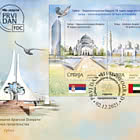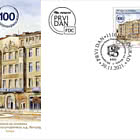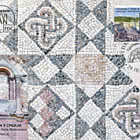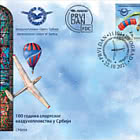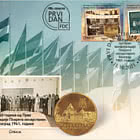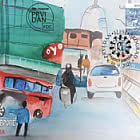2021Civil Engineering - First Day Cover
2021 Civil Engineering - First Day Cover for only GBP £0.89
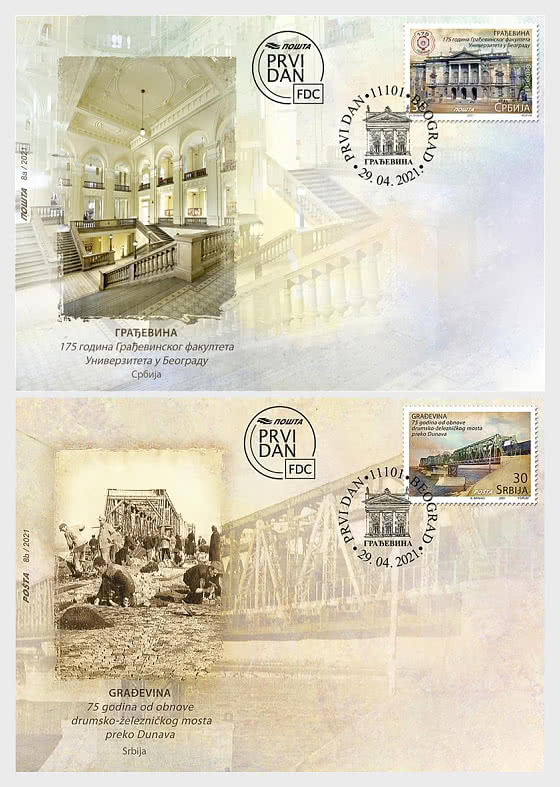
- 29.04.2021
The Faculty of Civil Engineering of the University of Belgrade is the oldest and leading educational and scientific institution of civil engineering and geodesy in Serbia. The beginning of higher education began on 19 June 1846, when on the initiative of Atanasije Nikolić, by profession a geodetic engineer, the "Engineering School" at the Lyceum in Belgrade was formed. Atanasije Nikolić was also the first rector of the Lyceum, the first president of the Society of Serbian Letters (the predecessor of SANU), but also the founder of the first theatre in Belgrade – the Theatre on Đumruk, in 1841.
When the Ministry of Construction of Serbia was established in 1862, the foundation of construction legislation in Serbia was laid. The following year, the Lyceum evolved into the Higher School with three faculties: Philosophical, Technical and Legal, which in 1905 grew into a University. On the site of the former "Race track", the Technical Faculty received a new, in many ways the most beautiful building in Belgrade in 1931. It was built according to the project of university professors Vojislav Zadjina, a civil engineer and at that time dean of the Technical Faculty, and architects Nikola Nestorović and Branko Tanazević, in the spirit of academism with dominant classicist elements. Today, this building houses three faculties of technical sciences: Civil Engineering, Architecture and Electrical Engineering.
Over the past 175 years, the forms of higher education, political circumstances, laws and curricula have changed. However, civil engineering and geodesy have remained engineering disciplines highly significant for the development of the state and society. In that period, almost 13,500 students graduated, about 550 received their master's degrees, and more than 370 engineers received their doctorates. Under the auspices of the Faculty of Civil Engineering in Belgrade, other faculties were established in Serbia and the surrounding area: in Novi Sad, Banja Luka, Podgorica. The impressive contribution of civil and geodetic engineers is built into the foundations of modern Serbia. A large number of scientists and public figures are among them, of whom Milutin Milanković and Nikola Pašić, both civil engineers, are probably the most famous.
Modern, recognizable and efficient, the Faculty of Civil Engineering today proudly celebrates its great jubilee. On the foundations of the glorious past, we create a better future, guided by the postulates written on the coat of arms of the Faculty: studere, docere, aedificare – research, educate, build. And this has been the case for 175 years.
Expert collaboration: Prof. Vladan Kuzmanović, Dean of the Faculty of Civil Engineering.
Artistic realization of the issue: Anamari Banjac, academic painter.
75 Years Since the Reconstruction of the Road-Railway Bridge Over the Danube75 years since the reconstruction of the road and railway bridge over the Danube will be marked in November 2021.
On 10th November 1935 Prince regent Pavle Karađorđević opened for public traffic the Pančevo railway and the new "Bridge of the King Petar Karađorđević".
The construction of the bridge attracted the attention of the public since it was one of the biggest in Europe. The total length was 1,526 m, out of which 1,134 m was above the water while the viaduct above the right riverside of the Danube was 134.9 m and the extension of the bridge above the left riverside was 256.8m.
The Pančevo Bridge was constructed by the German companies: "Deutsch Luxemburgisch Bergwerks und Hütten, A. G." (upper part) and "Siemens-Bauunion G.M.B.H. – Siemenstand" (concrete pillars, etc). Roadway was constructed by the French company "Batinol".
During the destruction in the Second World War, the Bridge was damaged. In April 1941 it was torn down by the Yugoslav Army in order to slow down the progress of Nazis, but the Germans repaired it for their needs. The Bridge suffered severe damage during the bombing of the Allies, and it was blown up after the withdrawal of occupiers from Belgrade in October 1944
The post-war reconstruction works on the Bridge started on 1st November 1945 executed by the Red Army that had a vast number of experts with the necessary mechanization, with the aid of a part of our First Railway Brigade. The Bridge was repaired by the end of 1946.
The first train over the reconstructed Red Army Bridge passed on 7th November 1946, and Josip Broz Tito put into operation the road part of the Bridge on 29th November with the simbolic ribbon cutting.
Expert collaboration: Railway Museum within JSC "Serbian Railways".
Artistic realization of the issue: Anamari Banjac, academic painter.
WOPA+ recommended stamp issues
| Music Giants VII - Iron Maiden |
| Issued: 12.01.2023 |
| ›Great Britain |
| Effigy of H.S.H Prince Albert II - Green Letter Rate |
| Issued: 03.01.2023 |
| ›Monaco |
| Year of the Rabbit |
| Issued: 05.01.2023 |
| ›Guernsey |
| Dimitrie Cantemir, 350th Anniversary of his Birth |
| Issued: 16.01.2023 |
| ›Romania |
| Medicinal Plants |
| Issued: 03.01.2023 |
| ›Romania |
| Lunar New Year - Year of the Rabbit |
| Issued: 05.01.2023 |
| ›Jersey |
| Honour Guard of the President of the Slovak Republic |
| Issued: 02.01.2023 |
| ›Slovakia |
| Veteran Tractors |
| Issued: 04.01.2023 |
| ›Aland Islands |
| St. Elizabeth’s Church in Parnu |
| Issued: 06.01.2023 |
| ›Estonia |

















